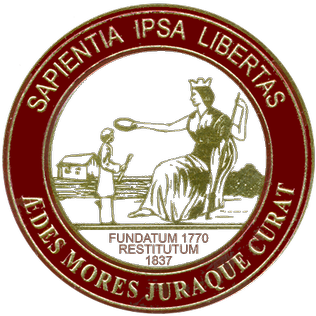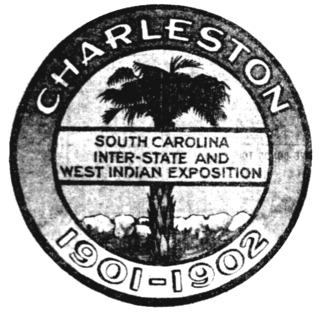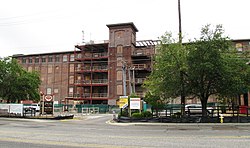
The College of Charleston is a public university in Charleston, South Carolina. Founded in 1770 and chartered in 1785, it is the oldest university in South Carolina, the 13th-oldest institution of higher learning in the United States, and the oldest municipal college in the nation.

The South Carolina State Museum is a museum dedicated to the history of South Carolina. It has four floors of permanent and changing exhibits, a digital dome planetarium, 4D interactive theater, and an observatory. The State Museum is located along the banks of the Congaree River in downtown Columbia, South Carolina. It is the largest museum in the state, and is a Smithsonian Affiliate and part of the American Alliance of Museums. Positioned on an old shipping canal that dates back to pre-Civil War times, the museum is widely recognized as a resource for South Carolina history and lifestyle. The museum opened on October 29, 1988, and is housed in what it calls its largest artifact the former Columbia Mills Building, listed on the National Register of Historic Places in 1982. When the mill opened in 1894, manufacturing cotton duck cloth, it was the first completely electric textile mill in the world. It was also the first major industrial installation for the General Electric corporation. On certain levels of the museum, the original flooring has been kept intact, distinguishable by the textile brads and rings that became embedded in the floor while it was still being used as a mill. The South Carolina Confederate Relic Room & Military Museum is located within the Columbia Mills Building and is the oldest museum exhibit in Columbia.

Joseph Patrick Riley Jr. is an American politician who served as the 60th mayor of Charleston, South Carolina from 1975 to 2016. A member of the Democratic Party, he also served in the South Carolina House of Representatives from 1968 to 1974 and was the 44th President of the United States Conference of Mayors from 1986 to 1987. Riley's 40 years as mayor were the longest in South Carolina history at the time of his retirement and are the longest in Charleston's history.

The City Market is a historic market complex in downtown Charleston, South Carolina. Established in the 1790s, the market stretches for four city blocks from the architecturally-significant Market Hall, which faces Meeting Street, through a continuous series of one-story market sheds, the last of which terminates at East Bay Street. The market should not be confused with the Old Slave Mart where enslaved people were sold, as enslaved people were never sold in the City Market. The City Market Hall has been described as a building of the "highest architectural design quality." The entire complex was listed on the National Register of Historic Places as Market Hall and Sheds and was further designated a National Historic Landmark.

St. Michael's AnglicanChurch is a historic church and the oldest surviving religious structure in Charleston, South Carolina. It is located at Broad and Meeting streets on one of the Four Corners of Law, and represents ecclesiastical law. It was built in the 1750s by order of the South Carolina Assembly. It is listed on the National Register of Historic Places and is a National Historic Landmark.

Old Bethel United Methodist Church is located at 222 Calhoun Street, Charleston, South Carolina. It is the oldest Methodist church still standing in the city.

The economy of South Carolina was ranked the 25th largest in the United States based on gross domestic product in 2022. Tourism, centered around Myrtle Beach, Charleston, and Hilton Head Island, is the state's largest industry. The state's other major economic sector is advanced manufacturing located primarily in the Upstate and the Lowcountry.

Charles Towne Landing State Historic Site in the West Ashley area of Charleston, South Carolina preserves the original site of the first permanent English settlement in Carolina. Originally opened in 1970 to commemorate South Carolina's tricentennial, this 664-acre (269 ha) site is home to an exhibit hall, rental facility, a natural habitat zoo, ongoing archeological excavations, miles of trails, dozens of picnic tables, a replica tall ship, six fireable replica cannon, and much more.

The South Carolina Inter-State and West Indian Exposition, commonly called the Charleston Exposition or the West Indian Exposition, was a multi-county fair and regional trade exposition held in Charleston, South Carolina from December 1, 1901 to June 20, 1902.

Magnolia Cemetery is a historic rural cemetery in Charleston, South Carolina. The first board for the cemetery was assembled in 1849 with Edward C. Jones as the architect. It was dedicated in 1850; Charles Fraser delivered the dedication address. It was listed on the National Register of Historic Places as a Historic District in 1978.

The history of Charleston, South Carolina, is one of the longest and most diverse of any community in the United States, spanning hundreds of years of physical settlement beginning in 1670. Charleston was one of leading cities in the South from the colonial era to the Civil War in the 1860s. The city grew wealthy through the export of rice and, later, sea island cotton and it was the base for many wealthy merchants and landowners. Charleston was the capital of American slavery.

Boeing South Carolina is an airplane assembly facility built by Boeing in North Charleston, South Carolina, United States. Located on the grounds of the joint-use Charleston Air Force Base and Charleston International Airport, the site is the final assembly and delivery point for the Boeing 787 Dreamliner. Boeing opened the site in July 2011, after purchasing the facilities of suppliers Vought and Global Aeronautica in 2008 and 2009. The final assembly building covers 1,200,000 square feet (110,000 m2) and opened on November 12, 2011. As of September 28, 2017, the site employs 6,943 workers and contractors.
The following is a timeline of the history of Charleston, South Carolina, USA.

Brookland Plantation is a large plantation along Shingle Creek on Edisto Island, South Carolina.

The South Carolina State Arsenal in Charleston, South Carolina was built in 1829 in response to the alleged 1822 slave revolt led by Denmark Vesey. The alleged uprising never came to fruition and Vesey was publicly hanged in 1822. In 1842 the South Carolina Military Academy, a liberal arts military college, was established by the state legislature, and the school took over the arsenal the following year as one of 2 campuses, the other being the Arsenal Academy in Columbia, South Carolina. The school became known as the Citadel Academy because of the appearance of its building. From 1865 to 1881, during Reconstruction, Federal troops occupied the Citadel, and the school was closed. Classes resumed in 1882 and continued in this building until the school was relocated to a new campus on the banks of the Ashley River in 1922.

The Hutchinson House is the oldest identified house on Edisto Island, South Carolina associated with the black community after the American Civil War. It was the residence of Henry Hutchinson, a freedman who was a noteworthy post-war Sea Island Cotton planter.

Emanuel African Methodist Episcopal Church, colloquially Mother Emanuel, is a church in Charleston, South Carolina, founded in 1817. It is the oldest AME church in the Southern United States; founded the previous year in Philadelphia, Pennsylvania, AME was the first independent black denomination in the nation. Mother Emanuel has one of the oldest black congregations south of Baltimore.

The Charleston City Hall is a building designed by Gabriel Manigault. The city bought the building and began using it as Charleston's City Hall in 1819, making it the second longest serving city hall in the United States.

The Robert Mills Manor is housing complex located in Harleston Village in Charleston, South Carolina that is included on the National Register.
The 1945–1946 Charleston Cigar Factory strike was a labor strike involving workers at the Cigar Factory in Charleston, South Carolina, United States. The strike commenced on October 22, 1945, and ended on April 1 of the following year, with the strikers winning some concessions from the company.























